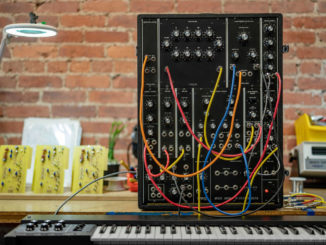Dreadbox Artemis is a new 6-voice desktop analog polyphonic Synthesizer with a built-in Sinevibes multi-FX processor.
Happy Birthday Dreadbox. Today, the Greek synth company will celebrate its 10th anniversary in Athens with a big party. In addition to a look back at the last years and a big musical program, a new Synthesizer will also be presented.
Today, Dreadbox unveiled Artemis, a new polyphonic analog synthesizer in collaboration with Sinevibes.
Dreadbox Artemis
Dreadbox Artemis is a new 6-voice analog polyphonic Synthesizer. After Typhon mono synth, the successful collaboration with Artemiy Pavlov of Sinevibes continues. They now raise their collaboration to the polyphonic level.
Artemis is a desktop unit with lots of hands-control with knobs and sliders backed in a lovely black box. The black sliders seem identical to the limited edition Murmux Adept polysynth.
Its analog core features two oscillators with waveshaping, PWM, and FM capabilities. A sub-wave and noise source are also onboard to add bottom end and little grid to your sounds. Interestingly, you have to choose between a sub and the noise. Both at the same time are not possible.
Like the Typhon mono synth, Artemis has a one-knob waveform control and other knobs, including an oscillator mixer and sub/off/noise. On faders, you get VCO 2 volume, detune, glide, pulse-width, and FM with a dedicated button that routes the envelope to it.
Then, the signal flows into two dedicated filters: a highpass filter with cutoff and resonance sliders via sliders and a smooth 24/12dB lowpass filter with knobs. The lowpass filter also has a keyboard track option and a drive to add juice to the filter.
Excitingly, filter FM is also available on a slider that can be archived with the noise generator, envelope, or one of the two LFOs.
Modulation & Sinevibes FX Power
Modulation must not be missing. Dreadbox Artemis has two ADSR envelopes (VCA, lowpass filter + VCO FM) and two polyphonic multi-wave LFOs with BPM sync, fade-in, and cross-mod options. The latter includes routings to the VCO pitch, wave, PW, and VCF cutoff.
For the LFOs, there are knobs and faders with switching, and for the envelopes, only sliders with a switch button. MPE, polyphonic aftertouch, and velocity are also onboard and can be mapped inside a mod matrix.
A highlight of the new Dreadbox Artemis is a full stereo multi-FX processor with four independent effects slots made in collaboration with Sinevibes. It has distortion, modulation effects, delay, and reverb with dedicated sliders that allow very playful interaction with them.
In the final stage, you have knobs for the master level and a stereo field spread option.
Dreadbox Artemis also features a polyphonic sequencer and an arpeggiator. The synth also supports polyphonic aftertouch and is MPE-compatible. And you can store all your polyphonic analog creations in 640 presets (10 banks of 64 each).
Connectivity
At the rear panel, you get a full-size 5-pin MIDI in/out, USB port, headphone socket, stereo audio output, and a power supply input. It is a pity there is no external stereo input to route other sounds into the Sinevibes effects. Like every Dreadbox product, it’s made in Athens, Greece.
First Impression
At first glance, it seems like a lovely new analog polyphonic Synthesizer with a modern twist. The features are classic: two oscillators, filters, envelopes, and LFOs. I especially like that they teamed up with Sinevibes again for the stereo effects. Also, plus points for the good preset storage and MPE/polyphonic aftertouch support.
However, I would have expected a bit more, especially in the modulations, like three envelopes and three LFOs. I’m looking forward for the first demos.
Dreadbox Artemis is available now for pre-order for $1399.
More information here: Dreadbox
Available for pre-order at my partners







Be the first to comment